
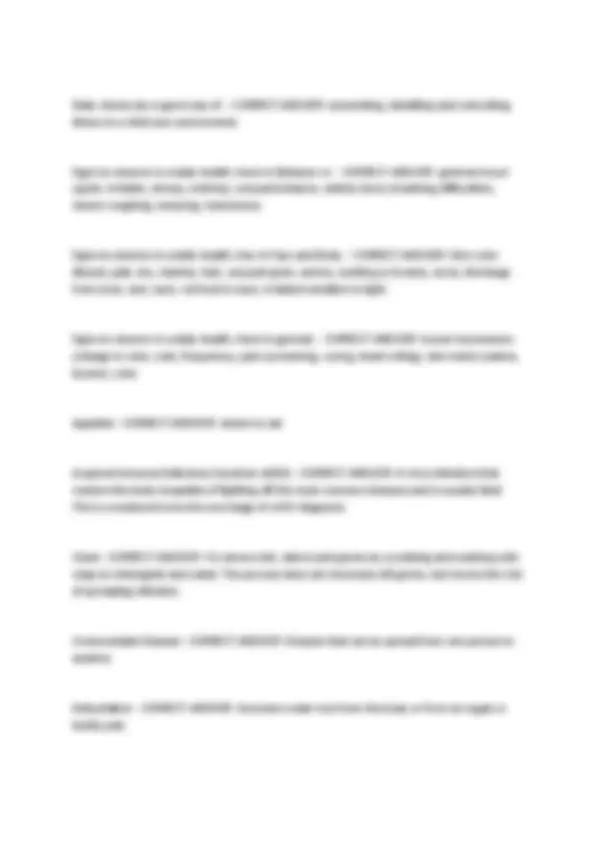
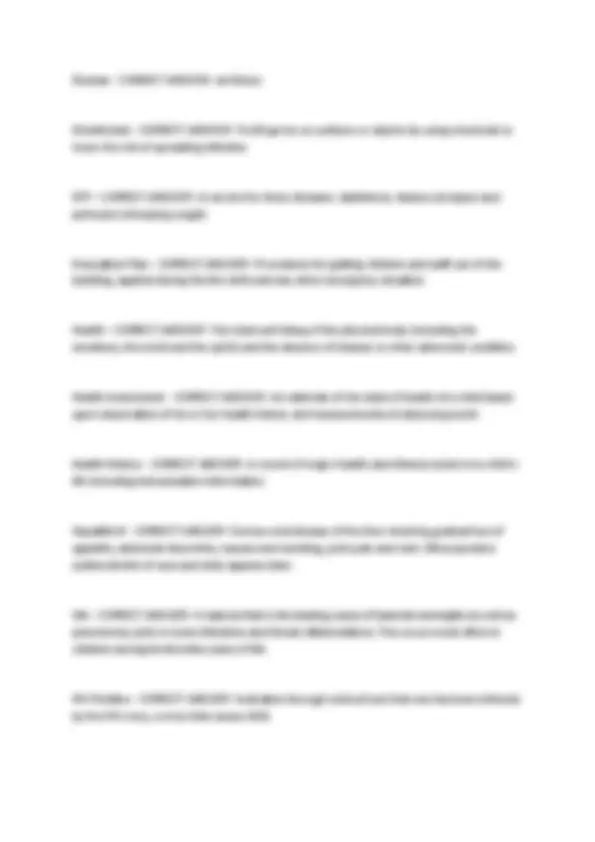
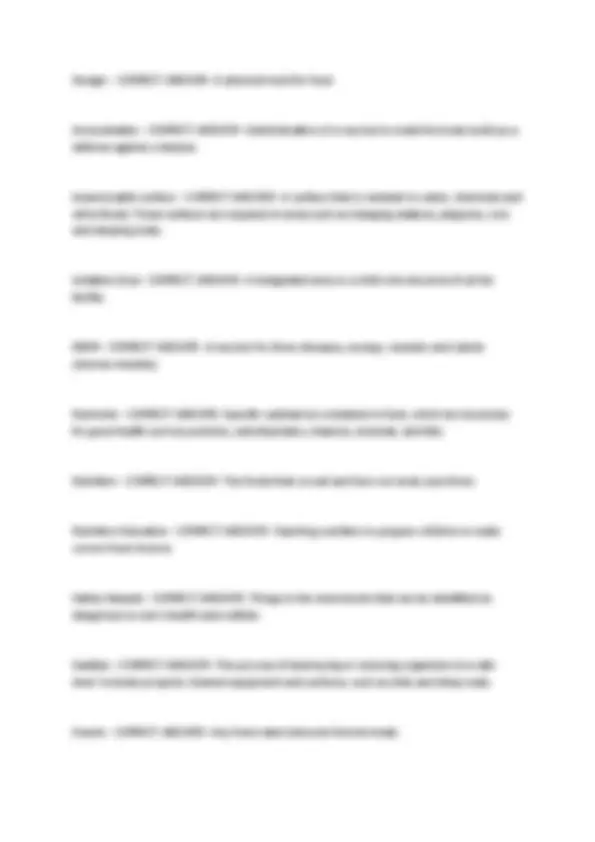
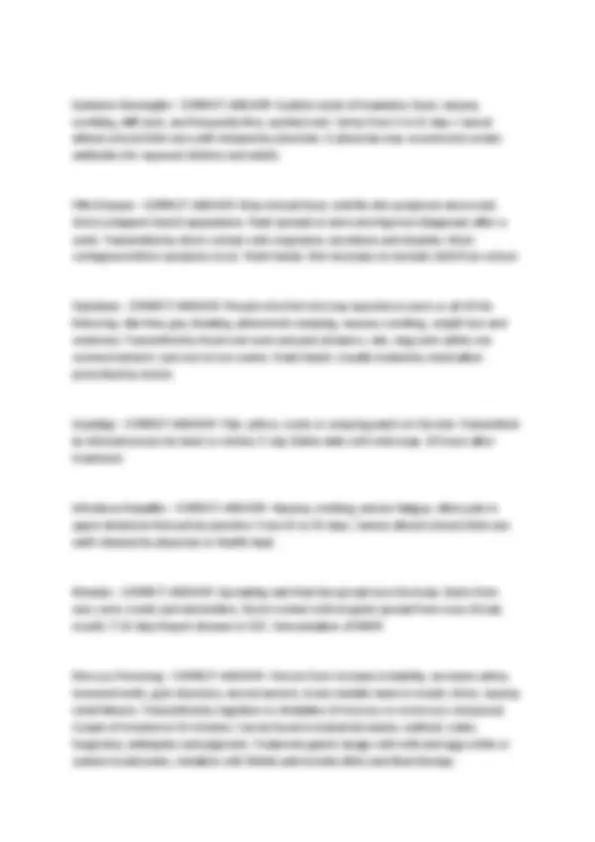
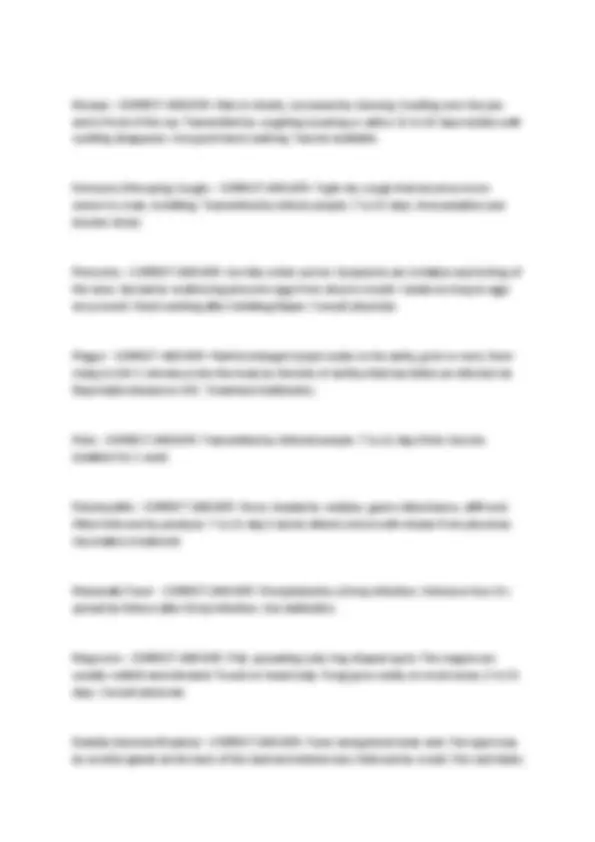
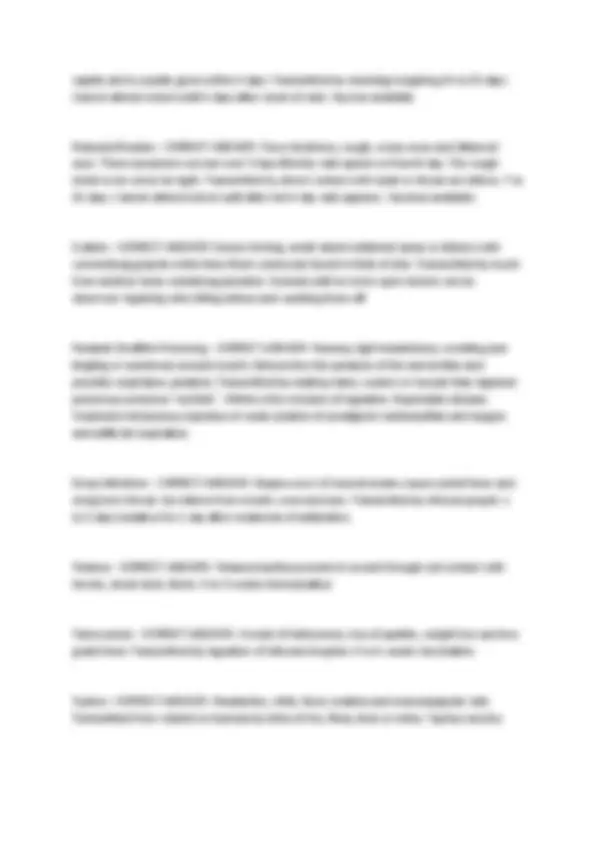
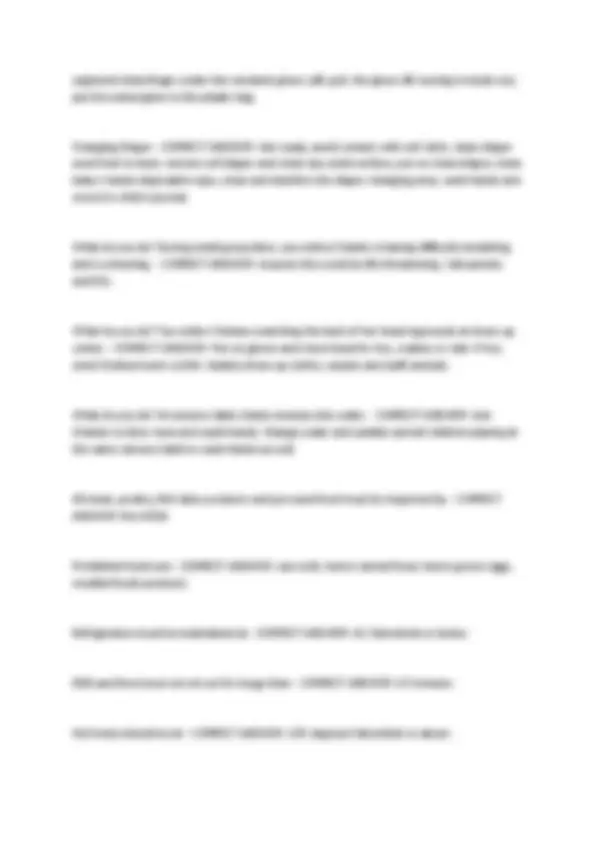
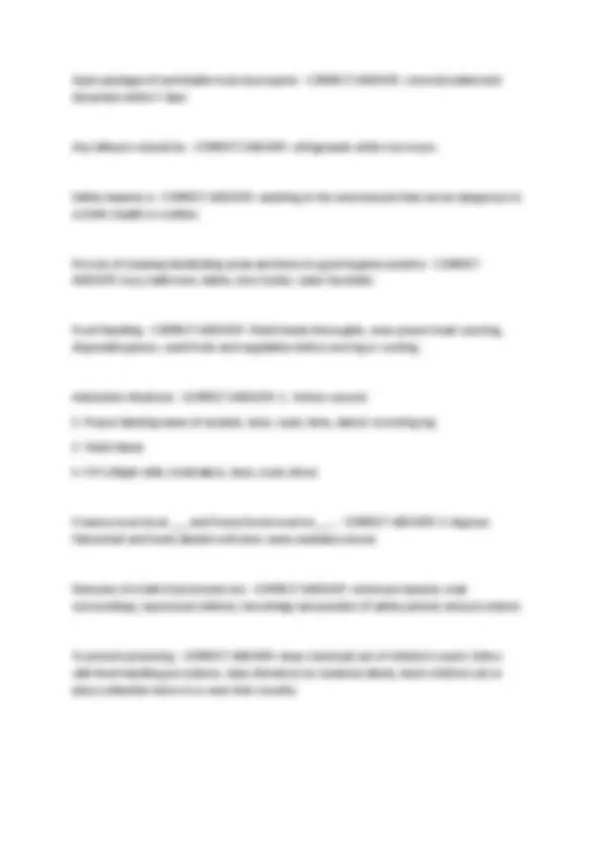
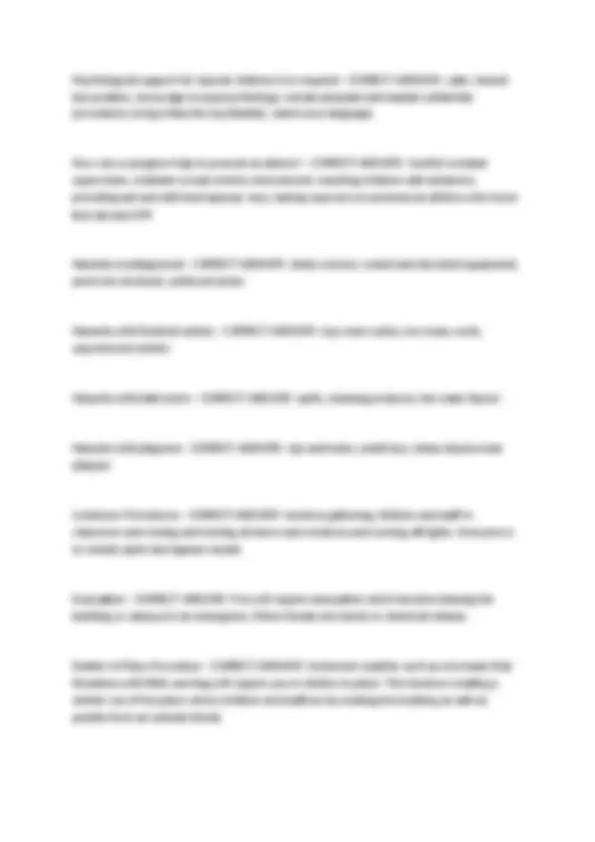
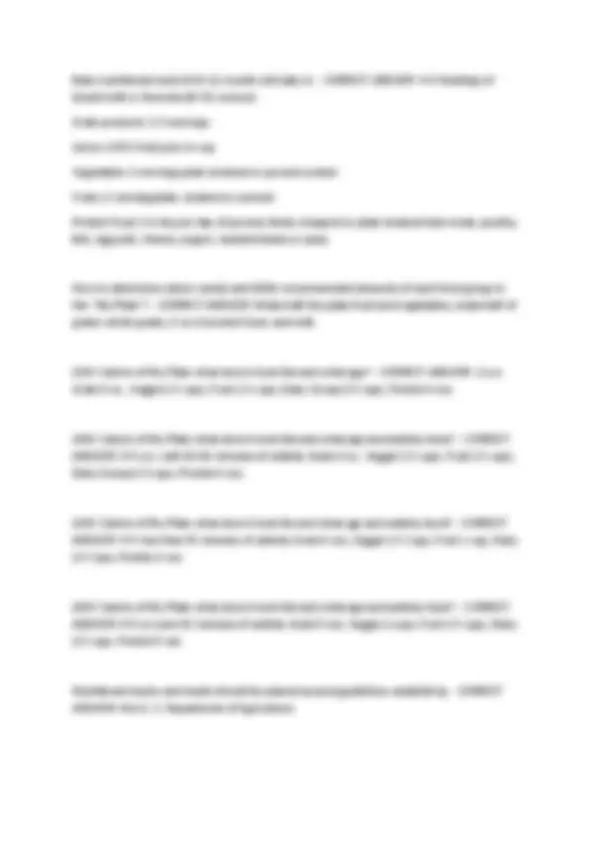
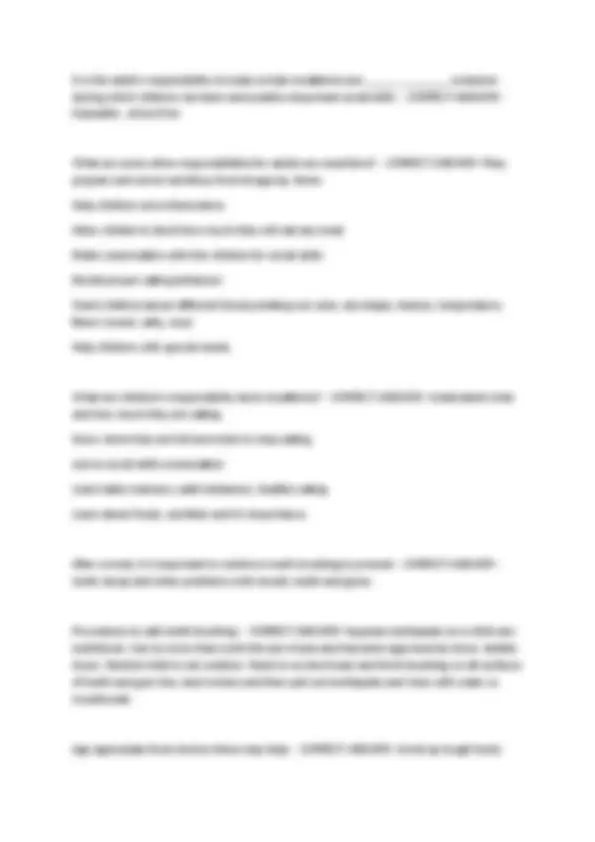
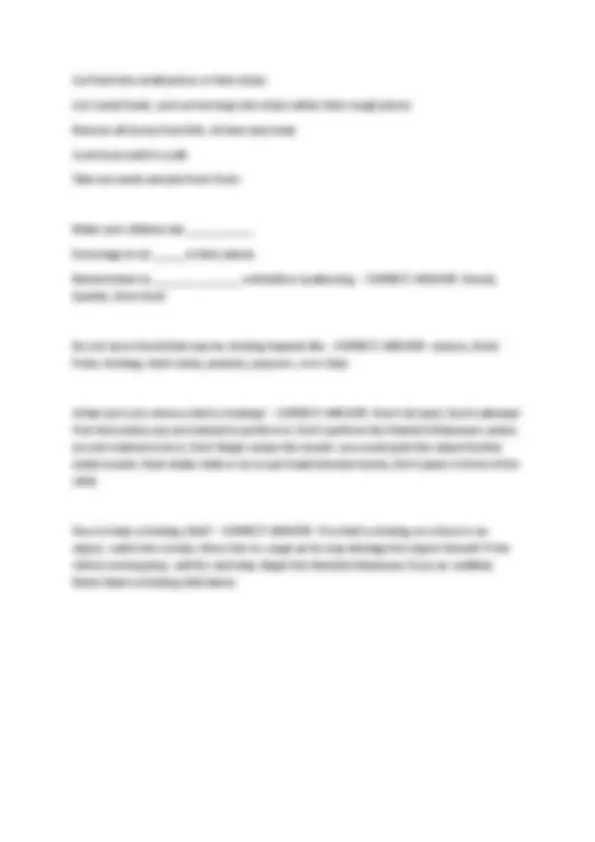


Study with the several resources on Docsity

Earn points by helping other students or get them with a premium plan


Prepare for your exams
Study with the several resources on Docsity

Earn points to download
Earn points by helping other students or get them with a premium plan
Community
Ask the community for help and clear up your study doubts
Discover the best universities in your country according to Docsity users
Free resources
Download our free guides on studying techniques, anxiety management strategies, and thesis advice from Docsity tutors
DCF HEALTH, SAFETY, AND NUTRITION What are the qualities of a Healthy Environment? - CORRECT ANSWER -Clean work and play area, proper hygiene practices, implementation and routine practice of a writen health policy. Why establish and follow a written health policy? - CORRECT ANSWER -It is an effective way of maintaining a safe and healthy child care program. How do you know if your program has a written policy? - CORRECT ANSWER -Ask your VPK program director and it usually posted in various areas like sink, kitchen, table Why should policies be written? - CORRECT ANSWER -1. To ensure parents and child care professionals are aware of procedures 2 to make sure everyone follows same rules. How is each sense used to observe a child (touch)? - CORRECT ANSWER -Check for too much warmth or coldness. How is each sense used to observe a child (smell)? - CORRECT ANSWER -Check for a bad smell or a change of smell.
Typology: Exams
1 / 20

This page cannot be seen from the preview
Don't miss anything!













What are the qualities of a Healthy Environment? - CORRECT ANSWER - Clean work and play area, proper hygiene practices, implementation and routine practice of a writen health policy. Why establish and follow a written health policy? - CORRECT ANSWER - It is an effective way of maintaining a safe and healthy child care program. How do you know if your program has a written policy? - CORRECT ANSWER - Ask your VPK program director and it usually posted in various areas like sink, kitchen, table Why should policies be written? - CORRECT ANSWER - 1. To ensure parents and child care professionals are aware of procedures 2 to make sure everyone follows same rules. How is each sense used to observe a child (touch)? - CORRECT ANSWER - Check for too much warmth or coldness. How is each sense used to observe a child (smell)? - CORRECT ANSWER - Check for a bad smell or a change of smell. How is each sense used to observe a child (taste)? - CORRECT ANSWER - Ask child if they taste something funny How is each sense used to observe a child (sound)? - CORRECT ANSWER - Check for breathing is it easy or ragged, etc. How is each sense used to observe a child (sight)? - CORRECT ANSWER - First observation of seeing a child's appearance and check all areas from head to toe.
The three A's of a healthy child are - CORRECT ANSWER - Appetite, Appearance and Activity Appetite signs of a healthy child are - CORRECT ANSWER - Can eat an appropriate amount of food at meal times. Will Consume a variety of foods. Is interested in eating? Appears content after meals/snacks. Appearance signs of healthy child are - CORRECT ANSWER - Has clear, bright eyes, clear skin, age appriopiate muscles, gains steadily in height/body weight Activity signs of a healthy child are - CORRECT ANSWER - Has plenty of energy (not hyperactive), is alert, sleeps soundly and has few aches and pains. Emotional health of a healthy child are - CORRECT ANSWER - a child who usually reflects happy, cheerful feelings Social health of a healthy child are - CORRECT ANSWER - a child who is friendly most of the time, interacts with other children and enjoys quiet activities that require concentration. Menal health of a healthy child are - CORRECT ANSWER - a child who is interested in new experiences and is usally confident and adaptable. Is a child with short-term emotional illness or disability a child with special needs. - CORRECT ANSWER - No Can you give examples of short-term illness or disability? - CORRECT ANSWER - Ear infections vs. hearing loss; cold vs. asthma; sprained ankle vs. foot deformity; distress over fight vs. depression What can you do to know what is normal for a particular child? - CORRECT ANSWER - Ask the parents for signs of well-being and their child normal displays.
Disease - CORRECT ANSWER - an illness Disinfectant - CORRECT ANSWER - To kill germs on surfaces or objects by using chemicals to lower the risk of spreading infection DTP - CORRECT ANSWER - A vaccine for three diseases: diphtheria, tetanus (lockjaw) and pertussis (whooping cough) Evacuation Plan - CORRECT ANSWER - Procedures for getting children and staff out of the building; applied during the fire drills and any other emergency situation. Health - CORRECT ANSWER - The total well being of the physical body (including the emotions, the mind and the spirit) and the absence of disease or other abnormal condition. Health Assessment - CORRECT ANSWER - An estimate of the state of health of a child based upon observation of his or her health history and measurements of phyiscal growth. Health History - CORRECT ANSWER - A record of major health (and illness) events in a child's life including immunization information. Hepatitis B - CORRECT ANSWER - Serious viral disease of the liver involving gradual loss of appetite, abdomial discomfot, nausea and vomiting, joint pain and rash. Often jaundice (yellowish tint of eyes and skin) appears later. Hib - CORRECT ANSWER - A bateria that is the leading cause of baterial meningitis as well as pneumonia, joint or bone infections and throat inflammations. This occurs most often in children during the first five years of life. HIV Positive - CORRECT ANSWER - Indication through a blood test that one has been infected by the HIV virus, a virus that causes AIDS.
Hunger - CORRECT ANSWER - A phyiscal need for food. Immunization - CORRECT ANSWER - Administration of a vaccine to make the body build up a defense against a disease. Impermeable surface - CORRECT ANSWER - A surface that is resistant to water, chemicals and other fluids. These surfaces are required in areas such as changing stations, playpens, cots and sleeping mats. Isolation Area - CORRECT ANSWER - A designated area or a child who becomes ill at the facility. MMR - CORRECT ANSWER - A vaccine for three diseases; mumps, measles and rubela (Geman measles) Nutrients - CORRECT ANSWER - Specific substances contained in food, which are necessary for good health such as proteins, carbohydrates, vitamins, minerals, and fats. Nutrition - CORRECT ANSWER - The foods that we eat and how our body uses them. Nutrition Education - CORRECT ANSWER - Teaching nutrition to prepare children to make correct food choices. Safety Hazards - CORRECT ANSWER - Things in the enviroment that can be identified as dangerous to one's health and welfare. Sanitize - CORRECT ANSWER - The process of destroying or reducing organisms to a safe level. Includes properly cleaned equipment and surfaces, such as sinks and sleep mats. Snacks - CORRECT ANSWER - Any food eaten between formal meals.
Yellow Fever - CORRECT ANSWER - Headache, jaundice, fever, vomiting and bleeding. Transmitted by mosquitos. It must be reported to CDC. Anthrax - CORRECT ANSWER - Reddish brown lesion that ulcerates and then forms a dark scab, later internal hemorhage, muscle pain, fever, vomiting. Transmitted by direct contact. It must be reported to CDC. Campylobacter - CORRECT ANSWER - Diarrhea, sometimes bloody, low grade fever abdominal cramping. Transmited by bowel movement from hands to objects to mouth or possible drinking water. Chicken Pox - CORRECT ANSWER - Slight fever, fine blisters appear first on scalp then on face and body. Isolation for 5-6 days after first appearance of blisters. Give acetaminophen for discomfort. Common Cold - CORRECT ANSWER - Runny nose, watery eyes, chilliness and malaise. Transmitted by contact wth infected people., cough suppressants or decongestants Conjunctivitis - CORRECT ANSWER - Pink Eye, Red eyes, eye discharge, crusted lids. Cannot attend child care/school until released by private physician. Good hand washing for prevention. Treatment Antibotics. Aspirin - CORRECT ANSWER - do not give to children. Coxsackie virus (Hand, foot and mouth disease) - CORRECT ANSWER - Mild fever, sore throat, sore mouth may look like cankersores, can have rash on hands, feet and buttocks. Transmited by fecal-oral route or respiratory secretion. Last for 3-6 days. Most infectious for 7 days after developing symptoms. Good hand washing. This infection is killed by heat, ultraviolet light and bleach. Diphtheria - CORRECT ANSWER - Sore throat and fever. Transmitted by contact with infected people. Last for 2-5 days. Isolated until 2 cultures from both nose and throat taken to show clear of bacilli. Refer to CDC. Vaccinations for diphtheria.
Epidemic Meningitis - CORRECT ANSWER - Sudden onset of headache, fever, nausea, vomiting, stiff neck, and frequently fine, spotted rash. Varies from 2 to 10 days. Cannot attend school/child care until released by physician. A physician may recommend certain antibiotics for exposed children and adults. Fifth Disease - CORRECT ANSWER - May include fever, mild flu-like symptoms and a rash. Gives a slapped cheeck appearance. Rash spreads to arms and legs but disappears after a week. Transmitted by direct contact with respiratory secretions and droplets. Most contagious before symptons occur. Wash hands. Not necessary to exclude child from school. Giardiasis - CORRECT ANSWER - People who feel sick may experience some or all of the following: diarrhea, gas, bloating, abdominal cramping, nausea, vomiting, weight loss and weakness. Transmitted by fecal-oral route and pets (beavers, cats, dogs and cattle) can receive/transmit. Last one to two weeks. Wash hands. Usually treated by medication prescribed by doctor. Impetigo - CORRECT ANSWER - Flat, yellow, crusty or weeping patch on the skin. Transmitted by infected person by hand or clothes. 5 day. Bathe daily with mild soap. 24 hours after treatment. Infectious Hepatitis - CORRECT ANSWER - Nausea, vimiting, extrem fatigue, often pain in upper abdomen folowed by jaundice. From 15 to 50 days. Cannot attend school/child care until released by physician or Health dept. Measles - CORRECT ANSWER - Spreading rash that has spread over the body. Starts from ears, neck, trunks and extremities. Direct contact with droplets spread from nose, throat, mouth. 7-14 days Report disease to CDC. Immunization of MMR Mercury Poisoning - CORRECT ANSWER - Chronic form includes irritability, excessive saliva, loosened teeth, gum disorders, slurred speech, Acute metallic taste in mouth, thirst, nausea, renal failuere. Transmitted by ingestion or inhalation of mercury or a mercury compound. Couple of minutes to 30 minutes. Can be found in industrial wastes, seafood, water, fungicides, antiseptics and pigments. Treatment gastric lavage with milk and eggs white or sodium bicarbonate, chelation with British anti lewisite (BAL) and fluid therapy.
rapidly and is usually gone within 3 days. Transmitted by sneezing/coughing 14 to 23 days. Cannot attend school until 4 days after onset of rash. Vaccine available. Rubeola Measles - CORRECT ANSWER - Fever tiredness, cough, runny nose and inflamed eyes. These symptoms worsen over 3 days Blotchy rash apears on fourth day. The cough tends to be worse at night. Transmitted by direct contact with nasal or throat secretions. 7 to 18 days. Cannot attend school until after teh 4 day rash appears. Vaccines available. Scabies - CORRECT ANSWER - Severe itching, small raised reddened areas or blisters with connectiong grayish-white lines Most commonly found in folds of skin. Transmitted by touch from another body containing parasites. Exclude until no more open lesions can be observed. Applying mite killing lotions and washing them off. Paralytic Shellfish Poisoning - CORRECT ANSWER - Nausea, light headedness, vomiting and tingling or numbness around mouth, followed by the paralysis of the extremities and possibly respiratory paralysis. Transmitted by easting clams, oysters or mussel that ingested poisonous protozoa "red tide". Within a few minutes of ingestion. Reportable disease. Treatment intravenous injection of weak solution of prostigmin methylsulfate and oxygen and artificial respiration. Strep Infections - CORRECT ANSWER - Steptoccocci of several strains cause scarlet fever and strep/sore throat. Secretions from mouth, nose and ears. Transmitted by infeced people. 1 to 3 days Isolation for 1 day after treatment of antibiotics. Tetanus - CORRECT ANSWER - Tetanus bacillus present in wound through soil contact with horses, street dust, farms. 4 to 3 weeks Immunization Tuberculosis - CORRECT ANSWER - Consist of listlessness, loss of apetite, weight loss and low grade fever. Transmitted by ingestion of infected droplets. 4 to 6 weeks Vaccination. Typhus - CORRECT ANSWER - Headaches, chills, fever, malaise and maculopapular rash. Transmitted from rodents to humans by bites of lice, fleas, ticks or mites. Typhus vaccine.
Vibrio Cholera - CORRECT ANSWER - Severe diarrhea and vomitting, muscular cramps, dehydration and depletion of electrolytes. Transmitted by spead by water and food that have been contaminated by feces of persons infected. Reportabel disease to CDC. Vaccination and boiling drinking water and eating only cooked foods. Treatment of antibiotics and drinking more water and electrolytes drinks. Recovery Position of Heat Stroke - CORRECT ANSWER - requires the person to be on back, stablized and airways open to prevent choking. www.redcross.org Steps to recover from dehydration - CORRECT ANSWER - Give plenty of water every 30 o 60 minutes, do not give milk, do not give sports drink, monitor food and drink intake, record temperature and communicate with parents. Call the parents, and if necessary suggest to the parents that the child needs ____________ attention. - CORRECT ANSWER - medical Fungi - CORRECT ANSWER - Grow best in warm, moist places. Can cause athlete's fod and ringworm. EFfective medication available. Medications work best when conditions favorable to fungal growth are removed. Virus - CORRECT ANSWER - Smaller than bacteria. Grow only in living cells. Can cause colds, chicken pox, measles, German Measles, mumps. Antibiotics have no effect. REst is the best action; body fights better when rested. Vaccines against common ones are available. Bacteria - CORRECT ANSWER - Small organisims seen with an ordinary microscope. CAn cause strep throat, impetigo, pink eye and som pneumonia. Antiboiotics help stop growth. Parasites - CORRECT ANSWER - Organisms that live on or in animals and people. Common examples include pinwoms, roundworms, head lice. Effective medications are available for most. List 4 ways diseases are transmitted. - CORRECT ANSWER - Respiratory - nose and throat discharges like colds, flu
ungloved index finger under the remainin glove cuff, pull, the glove off, turning it inside out, put the soiled glove in the plastic bag. Changing Diaper - CORRECT ANSWER - Get ready, avoid contact with soil cloth, clean diaper area front to back, remove soil diaper and clean any soied surface, put on clean diaper, clean baby's hands disposable wipe, clean and disinfect the diaper changing area, wash hands and record in child's journal. What do you do? During small group time, you notice Charles is having difficulty breathing and is wheezing. - CORRECT ANSWER - Assume this could be life threatening. Call parents and 911. What do you do? You notice Chelsea scratching the back of her head vigorously at dress-up center. - CORRECT ANSWER - Put on gloves and check head for lice, scabies or rash. If lice, send Chelsea home w/info. Santize dress-up clothe, carpets and stuff animals. What do you do? At sensory table chanie sneezes into water. - CORRECT ANSWER - Ask Chaniec to blow nose and wash hands. Change water and sanitize and all children playing at the same sensory table to wash hands as well. All meat, poultry, fish dairy products and procssed food must be inspected by - CORRECT ANSWER - the USDA Prohibited foods are - CORRECT ANSWER - raw milk, home canned food, home-grown eggs, recalled foods products Refrigerators must be maintained at - CORRECT ANSWER - 41 Fahrenheit or below Milk and food must not sit out for longe than - CORRECT ANSWER - 15 minutes Hot foods should be at - CORRECT ANSWER - 135 degrees Fahrenheit or above
Open packages of perishable must be properly - CORRECT ANSWER - covered/sealed and discarded within 7 days Any leftovers should be - CORRECT ANSWER - refrigerated within two hours. Safety hazards is - CORRECT ANSWER - anything in the environment that can be dangerous to a child's health or welfare. Process of cleaning disinfecting areas and items to good hygiene practice - CORRECT ANSWER - toys, bathroom, tables, door knobs, water fountains Food Handling - CORRECT ANSWER - Wash hands thoroughly, wear proper head covering, disposable gloves, wash fruits and vegetables before serving or cooking Administer Medicine - CORRECT ANSWER - 1. Writen concent
Best practices of Car Seats, Safety Belts, and the Law - CORRECT ANSWER - Children under 3 must be in secured child-restraint. Children under 4 through 5 secured in child-restraint or seat belt. Location-inside vehicle, direction-car seat faces, Seat belt path-correct, Tightness-firmness seat held in place. Food experiences also have an impact on: - CORRECT ANSWER - Social Skills or behaviors durng meal times. Motor Skill or dexteriy in handling utensils and food. When is it appropiate to prop bottle? - CORRECT ANSWER - Never. It is important to hold infants during this time. Where should you place the spoon when you feed a child solid food? - CORRECT ANSWER - In the middle of the child's tongue. When should you burp an infant during feeding? - CORRECT ANSWER - Middle and end. Basic nutritional needs of babies 0-4 weeks: - CORRECT ANSWER - 8 - 12 feedings of Breast milk or 14-43 ounces Formula Basic nutritional need of 1-4 month old baby is: - CORRECT ANSWER - 6 - 10 feedings of Breat milk or 14-43 ounces Formula Basic nutritional need of 4-6 month old baby is: - CORRECT ANSWER - 6 - 8 feedings of breask milk or 27-29 ounces Formula grain products: 1-2 servings iron fortified infant cereals (1-8 tbs. after mixing per day) juices: infant or regular 100 percent fruit juice only if able to drink from cup. Should you serve chocolate, citrus fruits, egg whites, shellfish, honey, salt, fat, seasonings within 0-12 months? - CORRECT ANSWER - No, they could be allergic to it and could make them sick. Also, they do not need them or will miss it either.
Should grain products, juices, vegetables, fruit and protein food be given to a baby at 0- 4 months? - CORRECT ANSWER - No, not at this point of life. Is it ok to give citrus, pineapple and tomatoe juices, vegetables, fruits and protein food at 4- 6 months of age? - CORRECT ANSWER - No, avoid given them these food at this point. Each age group has a _______ __________ needs that supply essential resources their bodies must have to grow and develop. - CORRECT ANSWER - specific nutritional Pincer grasp - CORRECT ANSWER - Babies at 5-9 months can pick up fod with their fingers. Basic nutritional need of 6-8 month old baby is: - CORRECT ANSWER - 4 - 6 feedings of breast milk or formula (24-32 ounces) Grain products: 2 servings Juices: 100% fruit juice in cup Vegetables: 1-2 servings plain strained or pureed cooked Fruits: 1-2 servingsplain, strained or pureed Protein Food: may be introduced Basic nutritional need of 8-10 month old baby is: - CORRECT ANSWER - 4 - 6 feedings of breast milk or formula (24-32 ounces) Grain products: 2-3 servings Juices: 100% fruit juice in cup Vegetables: 2 servings plain strained or pureed cooked Fruits: 2 servingsplain, strained or pureed Protein Food: 1-6 tbs per day of pureed, finely chopped or plain strained lean meat, poultry, fish, egg yolk, cheese, yogurt, mashed beans or peas.
It is the adult's responsibility to make certain mealtimes are _____, ________ ocassions during which children can learn and practice important social skills. - CORRECT ANSWER - Enjoyable , stress-free What are some other responsibilities for adults are meal time? - CORRECT ANSWER - Plan, prepare and servie nutritious food at approp. times Help children serve themselves Allow childen to decid how much they will eat any meal. Make conversation with the children for social skills Model proper eating behaviors Teach children about different foods pointing out color, size shape, texture, temperature, flavor (sweet, salty, sour) Help children with special needs. What are children's responsibility durin mealtimes? - CORRECT ANSWER - Understand what and how much they are eating. Know when they are full and when to stop eating Join in social skills conversation Learn table manners, eatin behaviors, healthy eating Learn about foods, nutritian and it's importance After a meal, it is important to reinforce tooth brushing to prevent - CORRECT ANSWER - tooth decay and other problems with mouth, teeth and gums. Procedures to safe teeth brushing: - CORRECT ANSWER - Squeeze toothpaste on a child-size toothbrust. Use no more than a dot the size of pea and has been approved by Amer. dentist Assoc. Remind child to not swallow. Teach to se short back and forth brushing on all surfaces of teeth and gum line, back molars and then spit out toothpaste and rinse with water or mouthwash. Age appropiate food choices these may help: - CORRECT ANSWER - Grind up tough foods
Cut food into small pieces or then strips Cut round foods, such as hot dogs into strips rather then rough pieces. Remove all bones from fish, chicken and meat Cook food until it is soft. Take out seeds and pits from fruits Make sure children eat ___________. Encourage to sit _____ in their places. Remind them to _______ _______ well before swallowing. - CORRECT ANSWER - Slowly, Quietly, Chew food Do not serve foods that may be choking hazards like - CORRECT ANSWER - raisons, dried fruits, hotdogs, hard candy, peanuts, popcorn, corn chips What not to do when a child is choking? - CORRECT ANSWER - Don't hit back, Don'ts attempt First Aird unless you are trained to perform it, Don't perform the Heimlich Maneuver unless you are trained to do it, Don't finger swipe the mouth- you could push the object further inside mouth, Dont shake child or try to put head between knees, Don't panic in front of the child. How to help a choking child? - CORRECT ANSWER - If a child is choking on a food or an object, watch him closely. Allow him to cough as he may dislodge the object himself. If the child is turning blue, call 911 and help. Begin the Heimlich Maneuver if you ar certified. Never leave a choking child alone.